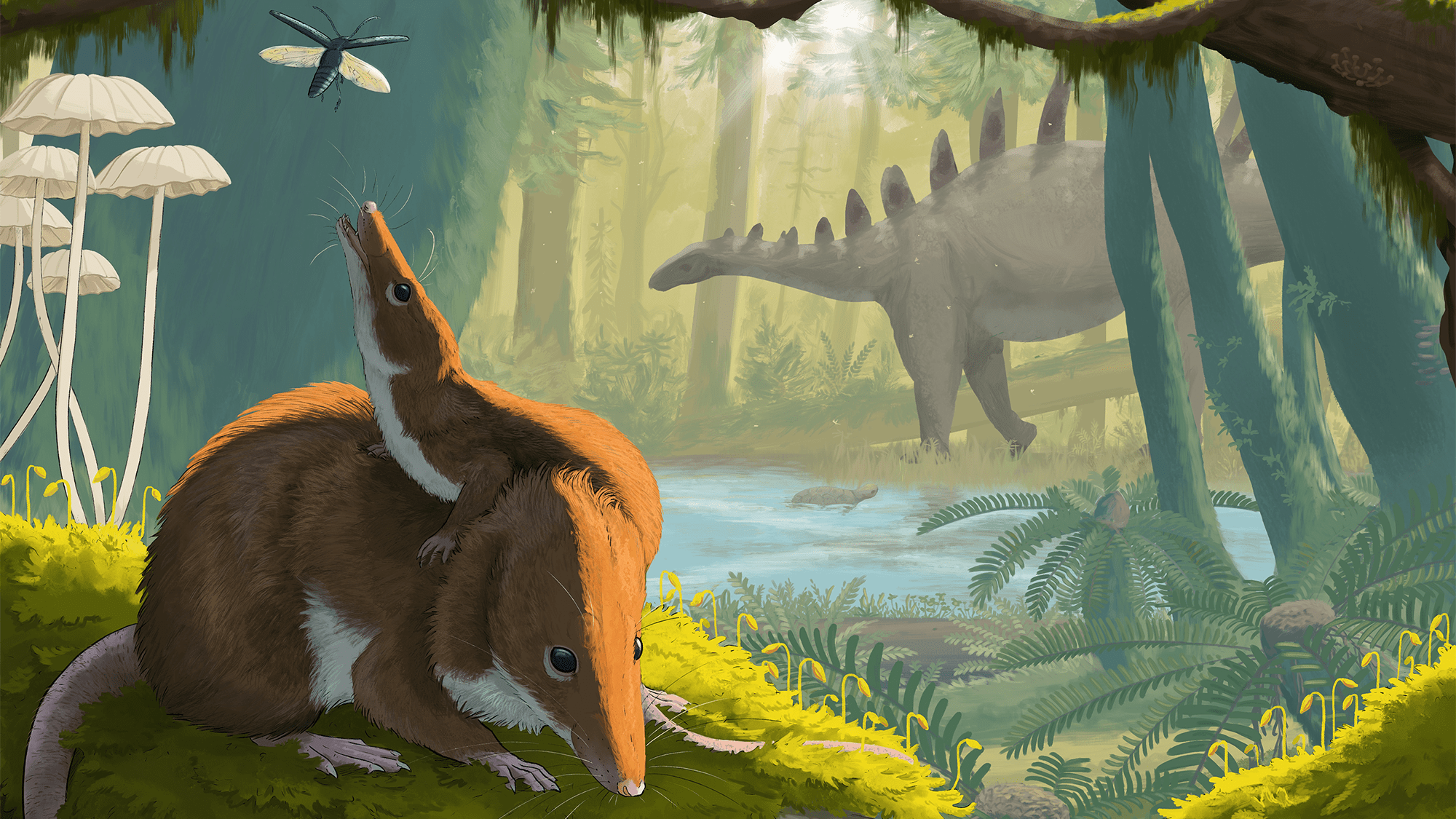
An artist’s impression of a small, early mammal called Krusatodon kirtlingtonesis. It lived among dinosaurs during the Middle Jurassic.
Maija Karala
A team of paleontologists combing through Scotland’s fossil-rich and misty Isle of Skye discovered the remains of a small, but exciting, early mammal. The mouse-sized creature called a Krusatodon was replacing its baby teeth with its adult teeth when it died and was a juvenile. Its ancient teeth-changing indicates that small early mammals may have had longer lifespans and development periods than their modern counterparts of a similar size. The findings are detailed in a study published July 24 in the journal Nature.
Meet the mammaliaformes
The specimens in this new study date back to the Middle Jurassic–about 166 million years ago. At this time, mammaliaformes–early mammals and their closest extinct relatives–were really starting to come into their own. One of the most common mammal orders at this time were the docodontans, who lived from Middle Jurassic to the Early Cretaceous. They are known for some distinct sets of chompers and are not a far cry from their living ancestors.
“For docodontans and other early mammals, life would have been similar to that of small mammals (like shrews and mice) today,” study co-author and National Museums Scotland paleobiologist Elsa Panciroli tells Popular Science.
[Related: New fossils of tiny, toothy early mammals could be a major missing link.]
Most of them ate insects and lived around the undergrowth where they were safe from predators–like a dinosaur’s clomping feet and sharp jaws. They would have been most active at dawn, dusk, and during the night.
“However, the docodontans are especially interesting because we know from their fossils that some of them grew larger (around the size of a polecat) and could also climb trees, swim, and dig,” says Panciroli. “They also ate a much wider range of foods, thanks to having the first very complex shaped teeth. In other words they were evolutionary innovators for their time period.”
Modern mammals typically grow rapidly as juveniles and stop growing by adulthood. As anyone who has owned a hamster can tell you, species with a smaller adult body mass generally develop quickly, mature at a younger age, live shorter lives, and have larger litters than those that are bigger.
Mammaliaformes generally weighed less than three ounces or so, but also had longer lifespans and slower growth rates than today’s small-bodied mammals. For scientists, understanding where this pattern emerged has been a challenge due to a lack of juvenile fossils.
Growing pains
The first fossil in this new study was uncovered back in 1972 and belonged to an adult docodontan species Krusatodon kirtlingtonensis. It was unstudied until Panciroli began to work on it a few years ago, but proved to be the most complete early mammal fossil ever uncovered in the United Kingdom. In 2016, a second Krustodon fossil was discovered. One that intrigued paleontologists.
“We soon realized it was the same species, and that it was a juvenile. This was incredibly exciting, because fossils of young mammals are exceptionally rare, especially from the Mesozoic,” says Panciroli. “We realized that there were questions about growth and development we could address with these two fossils together that haven’t been possible until now. From there, it was a case of figuring out the best methods to study them.”
The team analyzed the growth increments within the teeth of both specimens. They found that the adult was about seven years old when it died, while the juvenile was 7 to 24 months old when it died. The juvenile was also in the process of replacing its baby–or primary–teeth with its adult teeth.
Based on the length of the teeth and the forelimb and thigh bone circumferences, they estimate that the mature Krusatodon was between the size of a pygmy tree shrew (about two ounces) and a degu (roughly 5.5 ounces). The juvenile was roughly between 51 and 59 percent of the body mass of the adult.
The team believes that Krusatodon development was likely prolonged and took place over a longer period of time and part of a much longer maximum lifespan than living animals of a similar adult body size.
“In other ways they had already begun to grow like a modern mammal, they just took a lot longer to do it,” says Panciroli. “Despite growing more slowly, the pattern of their growth was similar to mammals today, so they tell us about a possible intermediate stage in mammal evolution.”
More than just Nessie
The Isle of Skye on Scotland’s northwestern coast is a fossil hotspot. It’s home to the remains, tracks, and footprints of a large variety of dinosaurs that lived during the Middle Jurassic Period. But that’s not all.
[Related: New pterosaur species discovered in Scotland.]
“The Isle of Skye is famous for dinosaur fossils, and although they are exciting, it is tiny fossils like these that are proving to be scientifically important,” says Panciroli. “They rank among the best in the world in terms of their preservation and completeness, but they also give us a glimpse into the origins of today’s ecosystems, and the major animal groups like mammals, lizards and amphibians.”
The team believes that mammal growth sped up later in the Jurassic, but are still not certain. They will need to find more fossils of younger mammals to determine this and piece together a better timeline. However, Panciroli is optimistic.
“Our team is making new discoveries every year, so it is a very exciting time for Scottish paleontology!” says Panciroli.
>>> Read full article>>>
Copyright for syndicated content belongs to the linked Source : Popular Science – https://www.popsci.com/science/jurassic-mammal-teeth/